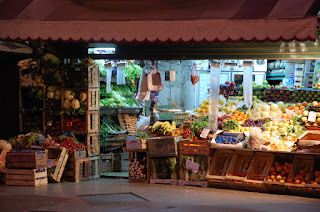
Eating out -- even in Buenos Aires -- can get old! During our four days in Mendoza, we enjoyed eight consecutive meals of slow food at Estancia La Florencia: brochette de pollo y lomo, asparagus soup, French omelette, bife de chorizo, huge salads of hearts of palm, avocado, baby asparagus, and olives, among other delights. With each meal we split a Bonarda/Malbec from Crotta or a pequena vasija of white wine from La Rural (Rutini) and mineral water con gas. The meals ran on for hours, making it possible for us to befriend waiters Daniel, Patricio, and Roberto, who gave us his exquisite recipe for chimichuri sauce. With tips, the meals averaged about $30 ARS, about $10 per person.
Eating out in Mendoza wasn't a novelty. Since arriving in Buenos Aires in May, we had been eating almost every meal out. Places like Croque Madame, Florencio, Teodoro's, Battaglia, Los Molinos, Los Pinos . . .
So on our first night back in Buenos Aires, we didn't feel like rushing out for dinner. Instead, Linda made garbanzos with chorizo estilo espanola, following Kurt's grandmothers' recipes to a T.
Last night we decided to try the "fabrica de pasta" we'd seen a couple of blocks from the apartment. We bought a half kilo of fresh fideos caseros to serve with the rattatoulie Linda had made earlier in the day, using black olives brought back from Mendoza and fresh vegetables from the produce stand down the block. We also picked up a pollo rostizado, much like the ones we used to get in Mexico but about twice the size, from a place called Traks. Rounding out the meal was a bottle of Syrah from Don Arturo's vineyard in Mendoza, also toted back on the plane in carry on luggage sans TSA issues.

Because we still have no furniture beyond the mattress on the floor and a camping chair, we ate at the counter in the pantry, using our new Argentine dinnerware.
Today the left-over chicken and pasta are being turned into an Argentine version of chicken noodle soup. Tomorrow, we may well be ready to try out Granda, a small French restaurant four blocks away known for its casserole cuisine.
Whether out or in, dining is good in Argentina.









 part of the greater Recoleta neighborhood.
part of the greater Recoleta neighborhood.